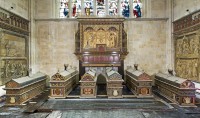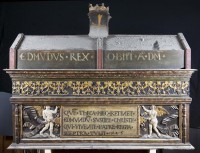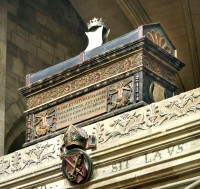 The great Gothic Cathedral of Winchester, in Hampshire, England, is traditionally held to be the final resting place of some of the earliest kings of Wessex and England. The remains of kings and bishops from as early as the 7th century are said to be contained in decorated mortuary chests in the church’s Lady Chapel. The chests are inscribed with names, crowns, shields identifying the remains kept in them, but they were made hundreds of years after the original burials in the Anglo-Saxon Old Minster (the original cathedral on the site of the current one from 660 to 1093) so it’s not certain they were ever accurate. On top of that, the chests were interfered with by Parliamentarians in 1642. When the cathedral authorities put the bones back, they were so jumbled up there was no way to separate out individuals.
The great Gothic Cathedral of Winchester, in Hampshire, England, is traditionally held to be the final resting place of some of the earliest kings of Wessex and England. The remains of kings and bishops from as early as the 7th century are said to be contained in decorated mortuary chests in the church’s Lady Chapel. The chests are inscribed with names, crowns, shields identifying the remains kept in them, but they were made hundreds of years after the original burials in the Anglo-Saxon Old Minster (the original cathedral on the site of the current one from 660 to 1093) so it’s not certain they were ever accurate. On top of that, the chests were interfered with by Parliamentarians in 1642. When the cathedral authorities put the bones back, they were so jumbled up there was no way to separate out individuals.
Over the years the chests have been cleaned and restored, but the human remains and artifacts within have not been examined in forensic detail. As part of a new development program aimed to promote and preserve the Cathedral and to create a better exhibition space in the south transept for the gem of its collection, the 12th century Winchester Bible, the Dean and Chapter of Winchester have commissioned experts to study and document the contents of six of the chests for the first time.
 Because modern technology allows for radiocarbon dating of very small samples, Winchester officials decided to date select bone fragments, something they’ve declined to do until now because it would have required the destruction of a some of the remains entrusted to Winchester’s eternal care. The results from the University of Oxford’s Radiocarbon Accelerator Unit found that the tested bones date to the late Anglo-Saxon and early Norman periods.
Because modern technology allows for radiocarbon dating of very small samples, Winchester officials decided to date select bone fragments, something they’ve declined to do until now because it would have required the destruction of a some of the remains entrusted to Winchester’s eternal care. The results from the University of Oxford’s Radiocarbon Accelerator Unit found that the tested bones date to the late Anglo-Saxon and early Norman periods.
Speaking of this discovery, and the coming project, The Dean of Winchester, The Very Revd James Atwell, has this to say. “This is an exciting moment for the Cathedral when we seem poised to discover that history has indeed safeguarded the mortal remains of some of the early Saxon Kings who became the first monarchs of a united England. Winchester holds the secrets of the birth of the English nation and it does seem that some of those secrets are about to be revealed as future research continues. The presence of the bones in the Cathedral, where they would have been placed near the High Altar and the relics of St Swithun, remind us just how significant the inspiration of the Christian faith was for the foundation of our national life.”
Researchers will also try to separate the jumbled bones to count the number of individuals. Once the remains have been collated, archaeologists hope to be able to determine their age at time of death, sex, stature and physical characteristics of each person. It’s possible that there will be enough circumstantial evidence to be able to loosely match the bones to the royalty and clergy that the chests and the Cathedral’s burial records claim were interred at Winchester. Possible candidates include: Cynegils, King of  Wessex (611–643), Cenwalh, King of Wessex (643–672), Cynewulf, King of Wessex (757-786), Ecbert, King of Wessex (802–839), Ethelwulf, King of Wessex (839–856), Eadred, King of England (946–955), Eadwig, King of England and later Wessex (955–959), Cnut or Canute, King of England (1016–1035), Denmark and Norway, his wife Emma of Normandy (d. 1052) (also queen consort to Ethelred II, King of England), William II ‘Rufus’, King of England (1087–1100), Wini, the first Bishop of Winchester (d. 670), Alfwyn, Bishop of Winchester (d. 1047) and Stigand, Archbishop of Canterbury (d. 1072).
Wessex (611–643), Cenwalh, King of Wessex (643–672), Cynewulf, King of Wessex (757-786), Ecbert, King of Wessex (802–839), Ethelwulf, King of Wessex (839–856), Eadred, King of England (946–955), Eadwig, King of England and later Wessex (955–959), Cnut or Canute, King of England (1016–1035), Denmark and Norway, his wife Emma of Normandy (d. 1052) (also queen consort to Ethelred II, King of England), William II ‘Rufus’, King of England (1087–1100), Wini, the first Bishop of Winchester (d. 670), Alfwyn, Bishop of Winchester (d. 1047) and Stigand, Archbishop of Canterbury (d. 1072).
If any one of these, particularly the early Anglo-Saxon kings, pan out forensically, Winchester Cathedral would be confirmed as the first national mausoleum, akin to the cathedrals of St. Denis and Reims in France.
There’s an intriguing little throw-away line with no follow-up in the press materials.
We have discovered in the chests some unexpected contents which are not mortal remains, and one of the aspects of the next stage of analysis will be to discover why they are there.
Ooh, unmentionable objects of mysterious origin! I’m looking forward to the explanation.